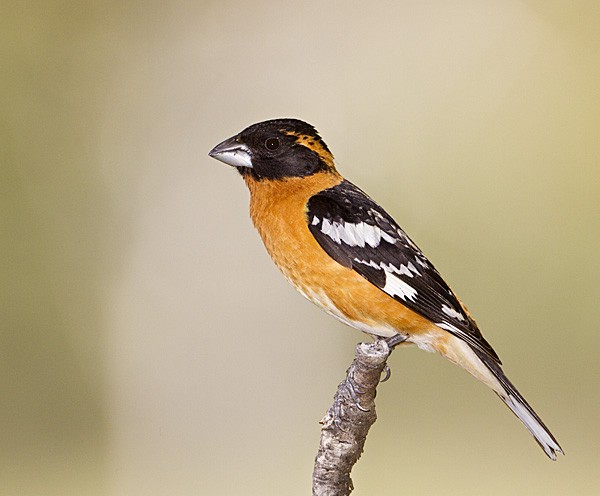Black-headed Grosbeak
A species of Typical New World Grosbeaks Scientific name : Pheucticus melanocephalus Genus : Typical New World Grosbeaks
Black-headed Grosbeak, A species of Typical New World Grosbeaks
Botanical name: Pheucticus melanocephalus
Genus: Typical New World Grosbeaks
 Photo By Eleanor Briccetti , used under CC-BY-SA-2.0 /Cropped and compressed from original
Photo By Eleanor Briccetti , used under CC-BY-SA-2.0 /Cropped and compressed from original Description
This large songbird can be identified by its extra large, conical bill with a thick base. The black-headed Grosbeak also has a short, thick tail, making its appearance just a little less than graceful. The males have an appealing orange-cinnamon color. When in flight, you can spot bright yellow flashes beneath the wings of both sexes.
Size
18-22 cm (7-8.5 in)
Life Expectancy
9.08 years (wild), 17-25 years (captivity)
Nest Placement
Tree
Clutch Size
2 - 5 eggs
Incubation Period
1 brood
Number of Broods
12 - 14 days
Nestling Period
10 - 14 days
Feeding Habits
Black-headed Grosbeak's diet consists primarily of insects (60%, with a preference for beetles), spiders, and fruits, supplemented with seeds (mostly berries, oats, wheat, and various weed seeds). Their robust bills allow them to crush hard-bodied invertebrates and snails. They consume orchard fruits and are unique in tolerating monarch butterfly toxins.
Habitat
Black-headed Grosbeak inhabit diverse landscapes, often at the confluence of varied vegetation types. Their favored habitats include riparian woodlands, forest edges, and mountainous pine areas with abundant large trees and understories, all requiring proximate water sources. They avoid homogeneous regions like dense forests. For breeding and wintering, black-headed Grosbeak select environments rich in plant diversity, extending to subtropical and tropical lowlands.
Nest Behavior
The female black-headed Grosbeak constructs the nest over 3-4 days, focusing on material gathering initially and assembly later. The nest's loose build helps keep eggs cool. Both parents share egg incubation and chick rearing responsibilities.
Nest Characteristics
Black-headed Grosbeak's nest is a bulky structure located in deciduous trees or bushes up to 25 feet high, often near streams. It measures around 5-7 inches across, with a 3-4 inch wide inner cup lined with rootlets and hair. Its loose construction offers egg ventilation.
Dite type
Insectivorous
People often ask
Migration Overview
Black-headed grosbeaks range from the Pacific Coast to the middle of the US Great Plains and from southwestern Canada to the mountains of Mexico. US and Canadian birds are highly migratory, wintering in Mexico. In the Great Plains, the range of the black-headed grosbeak and the rose-breasted grosbeak overlap and they have interbred somewhat. After the breeding season, they tend to seek out berry-rich areas. They migrate south early in the fall and return to the north late in the spring and have been known to do so in flocks.
General Info
Feeding Habits
Bird food type
Bird Feeder Type

Large Hopper

Platform
Sounds
Call
Recording location: Mexico
Song
Recording location: Mexico
Song
Recording location: United States
Behavior
Black-headed Grosbeak primarily forage in the treetops and understory, adept at gleaning food and catching insects mid-flight with their robust bills. Daily routines include hopping on branches and at feeders, skillfully cracking open seeds and tough insects. Post-migration, pairs quickly form through elaborate nuptial flights by males who display their striking wing patterns while singing. Territorial defense involves both sexes, with singing and sometimes aggressive aerial grappling against intruders. Remarkably, black-headed Grosbeak shows tolerance towards certain non-threatening species near their nests but fiercely defends against potential predators. Both genders participate equally in nesting duties, including incubation and feeding their young, and may join loose flocks for migration.
Species Status
Not globally threatened.